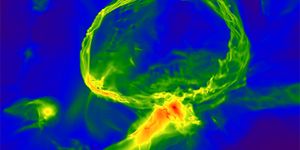Researchers Find Most Luminous Supernova to Date
A supernova is a rare event where a star nearing the end of its life explodes into a massive burst of bright light. Some are brighter than others, and others can be pretty dim.
Has the most luminous supernova ever seen just been observed? Scientists believe they’ve just discovered the brightest supernova ever, and it’s so bright it outshines the entire Milky Way galaxy by almost 50 times and is 570 billion times brighter than our own Sun at its peak.

Are you impressed yet? – You should be. That’s a lot of light!
The observed supernova, dubbed ASAS-SN-15lh is approximately 3.8 billion light years away and is putting out about 200 times the luminous power of most supernovas. More notably, it’s twice as bright as the previous record-holding supernova.
ASAS-SN-15lh was discovered with 14-centimeter telescopes by the All Sky Automated Survey for Supernovae (ASAS-SN) team, which is an international collaboration headquartered at Ohio State University in the United States in June of 2015.
"On June 14 of this year, we spotted a newly occurring explosion in a galaxy of an unknown distance," said Carnegie University’s Dr. Benjamin Shappee. "Subsequent observations--including those made at our Las Campanas Observatory by Nidia Morrell and Ian Thompson--allowed the team to confirm the existence of the supernova ASAS-SN-15lh."
During the study to learn more about the supernova, which appeared to have some very interesting and unusual traits, it was found that ASAS-SN-15lh was hydrogen and helium poor. It was in this study that scientists measured the supernova’s light intensity and found it has broken a record.
Other information found was that ASAS-SN-15lh formed in a very unusual place, which has scientists rethinking the boundaries over where supernovas are most likely to form and where they aren’t.
"The astounding amount of energy released by this supernova strains the magnetar-formation theory," Shappee explained. "More work will be necessary to understand this extraordinary object's power source and whether there are other similar supernovae out there in the universe."
Source: EurekAlert








